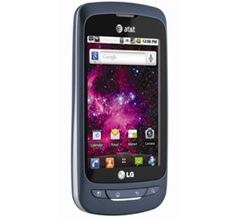 LG's value-priced Optimus One smartphone has finally made it over to AT&T. Dubbed the Phoenix here, it lets bargain hunters step to a real Android cell phone for just $29.99 with a two year contract. At this price, the Phoenix does the job just fine. But AT&T subscribers also have the ability to get a $49.99 Apple iPhone 3GS (4.5 stars), which makes the Phoenix a bit less compelling than its siblings on Sprint and T-Mobile.
LG's value-priced Optimus One smartphone has finally made it over to AT&T. Dubbed the Phoenix here, it lets bargain hunters step to a real Android cell phone for just $29.99 with a two year contract. At this price, the Phoenix does the job just fine. But AT&T subscribers also have the ability to get a $49.99 Apple iPhone 3GS (4.5 stars), which makes the Phoenix a bit less compelling than its siblings on Sprint and T-Mobile.
Design, Call Quality, and Apps
The LG Phoenix measures 4.5 by 2.3 by 0.5 inches (HWD) and weighs just 3.2 ounces. That's light for an Android phone, and this is the lightest Optimus variant by far. It's made mostly of a soft touch, slate blue plastic that's comfortable to hold. The 3.2-inch capacitive touch screen offers 320-by-480-pixel resolution; it's bright, if not particularly smooth to the touch, but it does the job. Four backlit, plastic function buttons sit beneath the screen, and have just the right amount of give. The on-screen QWERTY keyboards are a little cramped, but LG redesigned the keyboards to have slightly larger keys. The typing experience was okay; other phones are roomier and a bit more responsive.
The LG Phoenix is a quad-band EDGE (850/900/1800/1900 MHz) and tri-band HSDPA 7.2 (850/1800/2100 MHz) device with 802.11b/g Wi-Fi. You can also use it as a mobile hotspot for up to five devices with the appropriate optional data plan. LG's Optimus phones usually sound good with voice calls, and the Phoenix is no exception. Callers said I sounded clear through the microphone. Aside from the occasional computerized-sounding syllable, everyone sounded fine to me too. Reception was average. Calls sounded clear through an Aliph Jawbone Icon ($99, 4 stars) Bluetooth headset. Voice dialing worked fine over Bluetooth without training. The speakerphone sounded clear but needs more gain. Battery life was quite good at 6 hours and 30 minutes of talk time.
With the Phoenix, AT&T requires its usual minimum data plan starting at $15 per month. The Phoenix's Android credentials are fully intact: you get free voice-enabled, turn-by-turn GPS navigation, a great stock WebKit browser, powerful webmail and Microsoft Exchange integration, and access to over 150,000 third-party apps in the Android Market. The Phoenix runs Android 2.2 (Froyo). Although it packs an older Qualcomm MSM7227 600 MHz ARM11 processor, the device is responsive enough in day-to-day operation, in part thanks to LG's relatively light hand on the UI. The Phoenix isn't particularly fancy, but I'd have no problem using it as my personal smartphone.
Multimedia, Camera, and Conclusions
The microSD card slot is located underneath the battery cover; my 32GB SanDisk card worked fine, and LG throws in a 2GB card to get you started. There's also 162MB of free internal memory. Music tracks sounded clear and punchy through Samsung Modus HM6450 ($99, 4 stars) Bluetooth headphones. The stock music player displayed album art clearly and was simple to navigate. Standalone videos played well in full screen mode, though 720p files failed to play at all. The Phoenix isn't the best portable video player anyway, given its smallish LCD and somewhat subdued colors.
The 3.2-megapixel auto-focus camera has no flash. Test photos looked good, but not great; the same as with other LG Optimus phones. The camera sensor picks up a reasonable amount of detail, and outdoor shots looked relatively natural. But indoor shots in dimmer lighting exhibited too much grain. Recorded 640-by-480-pixel videos looked okay and played relatively smoothly at 18 frames per second, though the lack of image stabilization means you'll need a steady hand.
Our Editors' Choice for AT&T smartphones remains the Apple iPhone 4 ($199, 4 stars), but a better point of comparison here would be the iPhone 3GS. It costs just $20 more than the Phoenix; for that, you get access to the best app store in the industry, including much better gaming support, and it's also a real iPod. The Phoenix shares the iPhone 3GS's screen resolution, although the Phoenix's panel itself is a bit smaller. On the other hand, the Phoenix beats the iPhone with its free GPS navigation and smoother integration with Google services. Make no mistake, this is the best entry-level Android phone. But we'd keep an eye on prices for higher-end Android phones like the HTC Inspire 4G ($99, 4 stars) and Samsung Captivate ($99, 4 stars), both of which offer faster processors and larger, higher-resolution screens. Considering the high price you're paying per month, it may be worth it to pay a little bit more up front for a more powerful phone.
Benchmarks
Continuous talk time: 6 hours 30 minutes
No comments:
Post a Comment